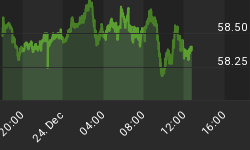"An important support for gold rallies... the $667/74 range will have to hold for a serious attempt at higher levels to be considered. The resistance between $682 and $686 still looms, however. Silver... with resistance just above $12 still keeping a lid on upward movement... reacted well to the 5-day moving average which... at least puts a level of support between the current price and targets as low as $9.50. Should the economic outlook deteriorate into anything resembling a recession or a deflationary spiral, there is no doubt the Fed will aggressively seek to remedy the situation, the eventual consequence of which will be a new leg in the precious metal bull, short term liquidations notwithstanding." ~ Precious Points: The Question of Deflation, August 25, 2007
A major premise of this weekly update since at least January finally began to receive some mainstream attention last week, namely that the precious metals have tended to trade in tandem with the major stock indices and are therefore not an ideal safe haven during massive liquidations. In fact, like stocks, health in the domestic and global economies is beneficial if not essential to the commodities bull market in general. Earlier updates emphasized the role of the metals ETFs and the speculation of huge institutional funds, while more recent editions emphasized the role of the Fed's rate-targeting regime and the susceptibility of metals in a liquidity crunch. It's not surprising, then, to see the trend continuing this week, with gold and silver closing higher on strong rallies that echoed the moves in equities.

The daily chart of gold above shows resistance coming in as expected in the $680/82 range after holding support above $667. A second consecutive close above the 5-week moving average in gold bodes well for a break of this resistance level, after which $690 and $700 become strong resistance.

The daily chart in silver shows the white metal clinging tenaciously to the 5-day moving average, right into last week's $12+ resistance, before Friday's rally catapulted silver cleanly through. Old resistance now becomes support.

The weekly chart, below, puts the first target for this encouraging move in silver near $12.40, about where RSI trendline resistance will also be met. A successful break above there could see as high as $12.60 with an eventual return to about $13, though probably not in a straight line.

Price action in both metals and stocks was driven again this week by the prevailing sentiment regarding the role of the Fed and the fate of the economy. As expected, the Fed instituted no policy changes this week, which from a strictly policy standpoint, was fairly bland. The only notable exception was a series of term repos late in the week that, because they're allowed to slosh for longer in the banking system, can have a potentially larger impact on money supply. Though this will not be reflected in the data, next week's M2 data will be an interesting gauge on exactly how much devaluation the Fed has undertaken since the onset of the current credit crisis.
Instead of shifts in policy, this week's Fed affect centered on two written statements from Chairman Ben Bernanke. The first, a letter to Chuck Schumer, did little than echo previous promises to use all of the Fed's resources in alleviating any liquidity crunch spillover into the larger economy. Despite the fact that this fell short of indicating anything other than that the Fed will continue taking every opportunity to avoid a cut in the target rate, markets and metals rallied. Given the desperate tenor of trade at that point, and the letter's explicit concern about mortgage defaults, the reaction was nevertheless fairly predictable.
Friday, in the much anticipated speech from Jackson Hole, Bernanke finally took concrete steps to soften his disciplinarian and data-dependent stance and amplify the August 17 statement that "downside risks to growth have increased appreciably." Certainly while the tone of the speech and its specific address of the so-called "moral hazard" of bailing out lenders, as well as the admission that sustained weakness in the financial markets could soften consumer spending and economic growth, tend to suggest the Fed has taken an outright rate-cutting bias, it should be noted the speech did not promise the Fed would necessarily be proactive in its accommodation. The new focus on the "timeliest indicators" suggests a more market sensitive approach, though, and while the nature of these chosen indicators is a matter of speculation, the daily effective funds rate, credit spreads, and yields of short term Treasuries all seem likely candidates.
Bernanke fell back in favor with Wall Street last week, but the speed with which the Street's sentiment fluctuates proves how rare is the discipline required of a central banker. This update has continually held Bernanke in high regard for his transparency and consistency, and in anticipation that no matter how the process unfolded, "helicopter Ben" would ultimately succeed in expanding the money supply - triggering the next wave of inflation and, resultingly, the next leg of the metals bull market.
So, as of Friday, the fate of the metals looks good in the very short term and the very long term, but, because it's not exactly clear how much more market pain the Fed will allow before capitulating, or how long before the target rate is again raised, volatility will continue and the possibility that a negative event or events may yet stand between here and new highs persist. One need only look to the recent history of the tech and housing bubbles to see that metals tend to rise not in the midst of contracting liquidity when rates are sinking, but in the following periods of economic expansion when liquidity is plentiful and rates are actually rising. With these new notes from the maestro, we are finally one small step closer to that refrain.
















